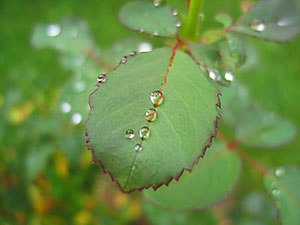 Some plants live with not just their roots under water, but large parts of their stems as well. The roots of these plants, which never contact the air at all, can sometimes lie more than 4 meters (13 feet) deep. It is impossible for oxygen to reach such depths by simple means. However, Allah has created the most appropriate system for these plants. The flawless aeration system in these plants, whose roots lie deep down under the water, can be compared to the structure of a skyscraper 300 meters (984 feet) tall and consisting of a hundred floors. In such high-rise buildings, one of the most important problems that engineers need to solve is that of aeration. Such buildings employ highly advanced technologies to resolve this difficulty. Many details—such as the air-conditioning spaces and their dimensions, the regions where the air conditioning units are to be installed, how fresh air is to be distributed to the different floors, and how used air is to be extracted from them—are all calculated while the building is still in the planning stages, and plans for the project are drawn up accordingly.
Some plants live with not just their roots under water, but large parts of their stems as well. The roots of these plants, which never contact the air at all, can sometimes lie more than 4 meters (13 feet) deep. It is impossible for oxygen to reach such depths by simple means. However, Allah has created the most appropriate system for these plants. The flawless aeration system in these plants, whose roots lie deep down under the water, can be compared to the structure of a skyscraper 300 meters (984 feet) tall and consisting of a hundred floors. In such high-rise buildings, one of the most important problems that engineers need to solve is that of aeration. Such buildings employ highly advanced technologies to resolve this difficulty. Many details—such as the air-conditioning spaces and their dimensions, the regions where the air conditioning units are to be installed, how fresh air is to be distributed to the different floors, and how used air is to be extracted from them—are all calculated while the building is still in the planning stages, and plans for the project are drawn up accordingly.
Certain regions in the blueprint are left empty in such a way as to form air shafts during the building’s construction, and air conditioning pipes can later be installed into them. Finally, the air-conditioning machinery itself and special air-conditioning systems are assembled on the various floors, and especially on the roof.
When a plant’s structures are closely examined, they can be seen to employ air conditioning systems within themselves far superior to those used in modern skyscrapers. This, of course, is a great miracle. The fact that an air conditioning system, an architectural and engineering marvel, is built into the internal structure of a plant devoid of any intelligence proves that the plant must have been created by a highly superior Intelligence.
The “engines” of this air-conditioning system are the leaves. Just as in a physical system, some structures must draw in clean air while other vents will expel the used air. Once again, the requisite planning has been carried out for a complete air-conditioning system to exist, and there is a perfect division of labor among the leaves. Younger leaves serve as the motors that draw fresh air into the plant, and older leaves expel the dirty air.
However, the presence of these engines on their own is not sufficient. There is also a need for air channels established in line with a specific plan: While fresh air is drawn in by the younger leaves, it must also be transported to those areas in the plant where it is needed. To fulfill this requirement, microscopic air-conditioning channels have been installed inside the plant to transport air to its very furthest reaches.
Now, to witness the flawless creation in Allah’s creation from even closer up, let’s examine the aeration system in the plant and how the young leaves function…The job of the young leaves is to absorb the air when the wind blows, and that of old leaves is to release the air to the outside. The working system in this inhalation and exhalation system is exceedingly complex. As water evaporates from leaves of this kind, the leaves’ temperature falls. Since wind increases evaporation, the temperature of the leaf thus falls even further—a process that becomes even more effective in strong winds. However, this cooling is not felt to the same extent in all parts of the leaf. The central regions of the leaf stay warmer than its external surfaces. According to researchers, when this temperature differential is greater than 1 or 2 degrees Celsius, it triggers the oxygen-absorbing process.
As water evaporates from leaves of this kind, the leaves’ temperature falls. Since wind increases evaporation, the temperature of the leaf thus falls even further—a process that becomes even more effective in strong winds. However, this cooling is not felt to the same extent in all parts of the leaf. The central regions of the leaf stay warmer than its external surfaces. According to researchers, when this temperature differential is greater than 1 or 2 degrees Celsius, it triggers the oxygen-absorbing process.
The triggering takes place in this way: when the inside of the leaf is magnified, the tissues of young leaves that carry out photosynthesis can be seen, along with very small pores leading to the loosely packed tissues underneath them. When the dimensions of these pores reach 0.7 micrometers (1 micrometer equals one millionth of a meter), and when the temperature in the leaf rises above 1 or 2 degrees Celsius, gasses begin to flow from the cold region in the leaf to the warmer region. In this way, oxygen is drawn towards the inside of the plant.
This process is known as thermo-osmosis. The greater the temperature differential, the more gas is absorbed into the leaf. For example, the highest level has been measured in the Amazonian lily at 30 liters (8 gallons) of gas an hour.
Thermo-osmosis is based on a physical law known as Knudsen diffusion. Under normal conditions, the gasses in two separate sections will pass freely through a porous barrier. However, small pores less than 1 micrometer in size will prevent this passage. Gasses seeking to establish equilibrium in terms of temperature then flow from the cold region to the warmer one. However, small pores less than 1 micrometer in size will prevent this passage.
The thermo-osmosis process draws air inside the plant with such a powerful pressure that gas can sometimes be seen rising from the roots in the form of bubbles. This inhalation/exhalation phase is completed by gasses being released by the old leaves. These old leaves no longer carry air inside them. Because their pores have widened more than necessary, they can no longer hold onto the gasses, which thus depart to the outside.
As you see, every feature of a plant is of vital importance, and clearly each one has been calculated and created to serve a specific purpose. This aeration system is not only important in terms of keeping underwater roots alive, but also ecologically. Sediments that accumulate at the bottom of deep water generally are poor in oxygen. They therefore harbor anaerobic bacteria that produce gasses such as iron hydroxide that are harmful to plants. But water plants neutralize these gasses by oxidizing them with the oxygen that they release from their roots. Thanks to this oxygen leakage, the soil around their roots becomes suitable for living things to live in, and thus the bottom of the lake or river is cleansed. This constitutes part of the complex system that directly affects the entire ecosystem on Earth and allows life to survive.
This aeration system is not only important in terms of keeping underwater roots alive, but also ecologically. Sediments that accumulate at the bottom of deep water generally are poor in oxygen. They therefore harbor anaerobic bacteria that produce gasses such as iron hydroxide that are harmful to plants. But water plants neutralize these gasses by oxidizing them with the oxygen that they release from their roots. Thanks to this oxygen leakage, the soil around their roots becomes suitable for living things to live in, and thus the bottom of the lake or river is cleansed. This constitutes part of the complex system that directly affects the entire ecosystem on Earth and allows life to survive.
As you have seen, there are flawlessly inter-related systems in even the smallest details of creation. Each of these details shows those who can reflect the magnificence of the omniscient Allah’s creation:
It is He Who made the Earth a cradle for you and threaded pathways for you through it and sent down water from the sky by which We have brought forth various different types of plants. Eat and pasture your cattle. Certainly there are Signs in that for people of sound intellect. (Surah Ta-Ha: 53-54)


